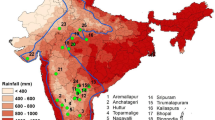Abstract
The multi-functionality of agriculture was studied from June to December 2005 in an upland community in Central Luzon, Philippines, by looking across the entire basin of two small water impounding systems or SWIP (Maasin and Buted II). Several sub-studies were undertaken, namely (a) the role of dominant vegetative cover on the rate of surface runoff and erosion; (b) rainfall–runoff analysis in a sub-watershed (i.e., through runoff experimental plot) and within the main watershed (i.e., reservoir inflow analysis); and (c) the environmental functions of agriculture across the entire watershed. The results indicated that about 85% (i.e., throughfall) of rainfall could reach the ground as vegetations intercept the rest. The runoff experimental plot covering a sub-watershed revealed a good correlation between throughfall and runoff. On the other hand, monitoring of reservoir inflows through which surface runoff was measured indicated similar behavior. Integrating the result of runoff experimental plot studies and reservoir inflow analysis resulted to a rainfall–runoff relation which can be applied in the development of rainwater harvesting scheme. The result also showed the dominance of surface runoff as the main component of reservoir inflow, confirming the soil and water conservation, and flood prevention functions of the system. Flood analysis conducted in both SWIP confirmed their flood prevention function by reducing flood peak discharge. The difference between with and without the reservoir was also highlighted in the process. In the paddy field, a 5-cm water depth was consistently maintained, contributing in retaining about 0.543 and 0.272 MCM of rainwater in Maasin and Buted II, respectively. The value of fostering groundwater recharge throughout the entire system was almost equivalent to the value of flood prevention function. Moreover, SWIP also trapped sediments, thereby preventing offsite impact downstream and in surrounding areas.









Similar content being viewed by others
References
Barker R, Molden D (2001) Sources of growth in water productivity in Asian irrigation. Report of the APO Seminar on Water Use Efficiency in Irrigation. Asian Productivity Organization. Japan, pp 19–31
Bureau of Soils and Water Management (1997) Manual for agro-hydrologic studies and dam design
Bureau of Soils and Water Management (2002) A manual on agro-hydrology and engineering design studies using Microsoft Excel
National Water Resources Board (2004) Raw water pricing and water rights. Philippine National Water Forum 2004 Proceedings. NWRB. Manila
Raghunath HM (1987). Recharge rates for different formations. In: Groundwater. 2nd edn. Wiley Eastern Limited, New Delhi, p 15, http://www.ecosystemvaluation.org/cost_avoided.htm
Author information
Authors and Affiliations
Corresponding author
Additional information
This paper is part of the progress report of the project “Multi-functionality of Agriculture in Selected Sites in the Philippines” presented in the 6th Meeting of the Working Group for the ASEAN-Japan Project on Multi-functionality of Agriculture in ASEAN Countries.
Rights and permissions
About this article
Cite this article
Concepcion, R.N., Contreras, S.M., Sanidad, W.B. et al. Enhancing multi-functionality of agriculture through rainwater harvesting system. Paddy Water Environ 4, 235–243 (2006). https://doi.org/10.1007/s10333-006-0057-3
Received:
Accepted:
Published:
Issue Date:
DOI: https://doi.org/10.1007/s10333-006-0057-3




